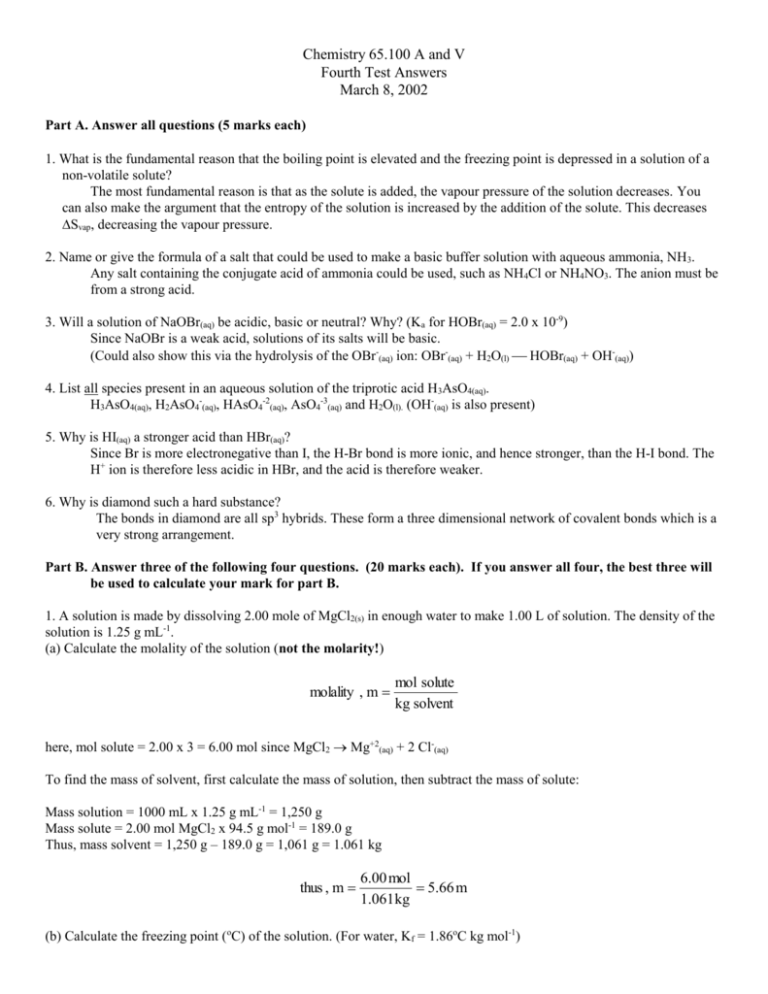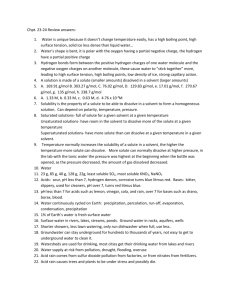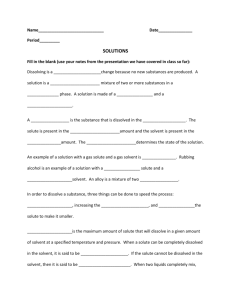test4ans
advertisement

Chemistry 65.100 A and V Fourth Test Answers March 8, 2002 Part A. Answer all questions (5 marks each) 1. What is the fundamental reason that the boiling point is elevated and the freezing point is depressed in a solution of a non-volatile solute? The most fundamental reason is that as the solute is added, the vapour pressure of the solution decreases. You can also make the argument that the entropy of the solution is increased by the addition of the solute. This decreases Svap, decreasing the vapour pressure. 2. Name or give the formula of a salt that could be used to make a basic buffer solution with aqueous ammonia, NH3. Any salt containing the conjugate acid of ammonia could be used, such as NH4Cl or NH4NO3. The anion must be from a strong acid. 3. Will a solution of NaOBr(aq) be acidic, basic or neutral? Why? (Ka for HOBr(aq) = 2.0 x 10-9) Since NaOBr is a weak acid, solutions of its salts will be basic. (Could also show this via the hydrolysis of the OBr-(aq) ion: OBr-(aq) + H2O(l) HOBr(aq) + OH-(aq)) 4. List all species present in an aqueous solution of the triprotic acid H3AsO4(aq). H3AsO4(aq), H2AsO4-(aq), HAsO4-2(aq), AsO4-3(aq) and H2O(l). (OH-(aq) is also present) 5. Why is HI(aq) a stronger acid than HBr(aq)? Since Br is more electronegative than I, the H-Br bond is more ionic, and hence stronger, than the H-I bond. The H+ ion is therefore less acidic in HBr, and the acid is therefore weaker. 6. Why is diamond such a hard substance? The bonds in diamond are all sp3 hybrids. These form a three dimensional network of covalent bonds which is a very strong arrangement. Part B. Answer three of the following four questions. (20 marks each). If you answer all four, the best three will be used to calculate your mark for part B. 1. A solution is made by dissolving 2.00 mole of MgCl2(s) in enough water to make 1.00 L of solution. The density of the solution is 1.25 g mL-1. (a) Calculate the molality of the solution (not the molarity!) molality , m mol solute kg solvent here, mol solute = 2.00 x 3 = 6.00 mol since MgCl2 Mg+2(aq) + 2 Cl-(aq) To find the mass of solvent, first calculate the mass of solution, then subtract the mass of solute: Mass solution = 1000 mL x 1.25 g mL-1 = 1,250 g Mass solute = 2.00 mol MgCl2 x 94.5 g mol-1 = 189.0 g Thus, mass solvent = 1,250 g – 189.0 g = 1,061 g = 1.061 kg thus , m 6.00 mol 5.66 m 1.061 kg (b) Calculate the freezing point (oC) of the solution. (For water, Kf = 1.86oC kg mol-1) Tf K f m 1.86C kg mol 1 5.66 mol kg 1 10.5C Thus , Tf 0.00C 10.5C 10.5C (c) Calculate the boiling point (oC) of the solution. (For water, Kb = 0.51oC kg mol-1.) Tb K b m 0.51C kg mol 1 5.66 mol kg 1 2.89C Thus , Tf 100.00C 2.89C 102.89C (d) Calculate the osmotic pressure (atm) of the solution at 25oC. (R = 0.082 L atm K-1mol-1) MRT 6.00 mol 0.082 L atm K 1mol 1 (25 273) K 1.00 L 146 atm (e) Calculate the vapor pressure (mm Hg) of the solution at 25oC. (The vapor pressure of pure water at 25oC is 23.8 mm Hg.) p p o X solv The mole fraction of the solvent is found from the number of moles of the solvent and solute. n solute 6.00 n solv 1061 g 58.9 18.0 g mol 1 thus , X solv n solv 58.9 0.908 n solv n solute 58.9 6.00 thus , p 23.8 mm Hg 0.908 21.6 mm Hg 2. A buffered solution contains lactic acid, HC3H5O3(aq) (Ka = 1.4 x 10-4) and sodium lactate, NaC3H5O3(aq). (a) Calculate the pH of a solution containing 0.75 M lactic acid and 2.00 M sodium lactate. [acid ] pH pK a log 10 [base] pK a log 10 (K a ) log 10 (1.4 10 4 ) 3.85 0.75 M thus , pH 3.85 log 10 2.00 M 4.28 (b) Calculate the concentration of sodium lactate required to give a pH of 5.00 in a solution of 1.00 M lactic acid. Rearranging the Henderson Hasselbalch equation, [acid ] pK a pH [base] [acid ] or, 10 ( pKa pH) [base] [acid ] or, [base] ( pKa pH) 10 1.00 M 3.855.00 14.1 M 10 log 10 (c) 0.10 mol of NaOH are added to 1 L of the buffered solution in part (a). Calculate the resultant pH. First, the added base titrates an equivalent amount of acid according to: HC3H5O3(aq) + OH-(aq) C3H5O3-(aq) + H2O(l) Thus, the acid concentration decreases to (0.75 – 0.10) = 0.65 M and the lactate ion concentration increases to (2.00 + 0.10) = 2.10 M. The pH is found from the Henderson-Hasselbalch equation: [acid ] pH pK a log 10 [base] 0.65 M 3.85 log 10 2.10 M 4.36 3. Calculate the pH and concentrations of all species present in a 1 M aqueous solution of the triprotic citric acid, C6H8O7(aq). For this acid, Ka1 = 7.1 x 10-4, Ka2 = 1.7 x 10-5 and Ka3 = 4.1 x 10-7. C6H8O7(aq) + H2O(l) H3O+(aq) + C6H7O7- (aq) [H 3 O ( aq ) ][C 6 H 7 O 7 [C 6 H 8 O 7 ( aq ) ] Initial, M Change, M Equilibrium, M Thus at equilibrium, ( aq ) ] K a1 7.1 10 4 C6H8O7(aq) H3O+(aq) C6H7O7- (aq) 1.00 0 0 -x +x +x 1.00-x x x x2 7.1 10 4 1.00 x Solving, x = 0.027 (no need to use the quadratic equation here since Ka < 10-3) Thus, [H3O+(aq)] = [C6H7O7-(aq)] = x = 0.027 M pH = -log10[H3O+(aq)] = -log10(0.027) = 1.57 [C6H8O7(aq)] = 1.00 – x = 0.973 M The concentration of the second hydrolysis product, C6H6O7-2 (aq), is found from: C6H7O7-(aq) + H2O(l) H3O+(aq) + C6H6O7-2 (aq) [H 3 O ( aq ) ][C 6 H 6 O 7 [C 6 H 7 O 7 ( aq ) 2 ( aq ) ] ] K a 2 1.7 10 5 2 x[C 6 H 6 O 7 ( aq ) ] 1.7 10 5 x 2 [C 6 H 6 O 7 ( aq ) ] 1.7 10 5 And the concentration of the third hydrolysis product, C6H5O7-3 (aq) is found from: C6H6O7-2(aq) + H2O(l) H3O+(aq) + C6H5O7-3 (aq) [H 3 O ( aq ) ][C 6 H 5 O 7 [C 6 H 6 O 7 or, [C 6 H 5 O 7 3 2 ( aq ) 3 ] ( aq ) ] K a 3 4.1 10 7 4.1 10 7 [C 6 H 6 O 7 ( aq ) ] [H 3 O ( aq ) ] 2 ( aq ) ] 4.1 10 7 (1.7 10 5 ) 2.62 10 10 M 0.027 4. An element crystallizes in a face centred cubic lattice and has a density of 1.45 g cm-3. The edge of its unit cell is 4.52 x 10-8 cm. Calculate the atomic mass of the element. The volume of the unit cell = V = l3 = (4.52 x 10-8 cm)3 = 9.23 x 10-23 cm3 The mass of the unit cell = density x volume = 1.45 g cm-3 x 9.23 x 10-23 cm3 = 1.34 x 10-22 g The unit cell in a face centred lattice contains 4 atoms. Thus, each atom has a mass of 1.34 x 10 -22 g / 4 = 3.35 x 10-23 g A mole of atoms thus have a mass of 3.35 x 10-23 g x 6.02 x 1023 mol-1 = 20.1 g mol-1








